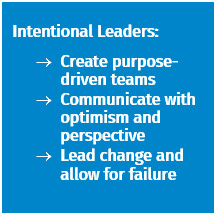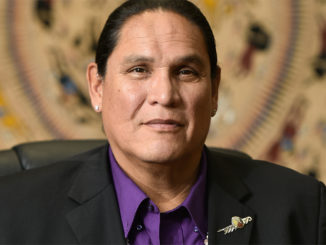
What is an intentional leader?
An intentional leader acts rather than reacts. They are self-aware and very deliberate in what they stand for and how they plan for creating their leadership milestones. They are caring and compassionate, with a willingness to share, be vulnerable, model behavior, and have an openness to change.
Importantly, intentional leaders are committed to developing other leaders and are deliberate in taking the time and effort it takes to do so. Author Simon Sinek says, “The greatest contribution of a leader is to make other leaders.” The ultimate test of a leader’s skill is their ability to create an intentional long-term impact on the organization and individuals.
Share knowledge – For many leaders, holding knowledge gives the individual a perception of power. “If I am the only one who knows this information, I am irreplaceable.” In fact, the opposite is true. Failing to cross-train can actually prevent a leader from advancing within the organization. A powerful leader has the confidence and trust of the team to create opportunities and processes for individuals within the organization to learn and grow.
Vulnerable – This means the willingness to say, “I don’t know.” Nobody has all the answers. Leaders who show vulnerability create trust within the team. It shows others that it is okay to ask for assistance or clarification without fearing consequences.
Modeling behavior – Many leaders believe this is the primary way to create new leaders. It is true that leaders are always being watched. Therefore, modeling behavior happens organically, both positively and negatively. While modeling is a critical first step, it is only one piece to creating powerful leaders.
Openness to change – Without change, organizations and leaders can become obsolete. Powerful leaders recognize this and are receptive and open to new ideas or change. This shows others that you are responsive to other people’s suggestions and willing to consider new ways of thinking.
How an Evidence-Based Leadership approach creates a culture of quality
The Evidence-Based Leadership framework began in the healthcare industry and aimed to create high-quality patient care in every interaction. Since clinician interactions within a healthcare organization can have life-or-death outcomes, every interaction must be performed consistently to ensure a quality outcome. For the model to work, it was critical to develop a framework for creating effective leaders who could align goals, processes and behaviors. The foundation of an Evidence-Based Leadership model is to create measurable behaviors and a mechanism for accountability. As the model is implemented, organizations that utilize the Evidence-Based Leadership (EBL) framework saw improvement in team member engagement and patient outcomes.
The approach is not about how to lead, but what to give our attention to as leaders. It’s about how we inspire, communicate and lead our teams to improvement by closing the operational gaps. Many times, organizations seek to improve quality by implementing a new program or process. This is typically done without examining existing processes that are negatively impacting the organization. Additionally, they fail to explain the reasoning behind the potential changes. Without addressing the existing structure and understanding the “why” behind the decisions, many times teams are left confused or reluctant to implement the change, instead seeing it as the “program of the week.”
When correctly executed, leaders and their teams understand the organization’s mission, how success is measured (accountability), and the behaviors that lead to success.

Does this work in the casino and hospitality industry? Absolutely!
Casinos are highly regulated, policy-driven businesses. At times, this creates difficulty for leaders who are trying to maintain policy integrity while trying to balance the needs of the team and guests’ demands or desires. An evidence-based leadership approach in casinos and hospitality develops guidelines for creating best practices using informed decision-making. Over time leaders begin to understand the need to base decisions on multiple data sources rather than “trusting their gut.”
Example:

Transparency and accountability in decision-making. Critical components of a high-performing organization.
In practice, implementing these principles can put leaders in a difficult position. When information about the performance of the organization is transparent, there is pressure on the leader to acknowledge any lack of performance when targets are missed. Many times, this pressure prevents leaders from setting performance standards and sharing the results. This creates ignorance and a reactive management style within the organization.
However, organizations that practice quality decision-making that consists of research or knowledge, transparency and accountability, and share the responsibility with the team, create a higher level of trust, teamwork, team member satisfaction and performance.
The impact of an intentional leader
 Leaders spend a great deal of time focusing on solving external problems or driving initiatives within the organization, but rarely allow themselves space to evaluate their personal motivation or management style. Our effectiveness as leaders can either inspire others or do damage. Intentional leaders consider more than the business goal, but rather, the impact on the team and the core values of the organization to ensure decisions are aligned with the vision of the organization. Additionally, the leader is mindful of their impact on the team and strives for continuous learning.
Leaders spend a great deal of time focusing on solving external problems or driving initiatives within the organization, but rarely allow themselves space to evaluate their personal motivation or management style. Our effectiveness as leaders can either inspire others or do damage. Intentional leaders consider more than the business goal, but rather, the impact on the team and the core values of the organization to ensure decisions are aligned with the vision of the organization. Additionally, the leader is mindful of their impact on the team and strives for continuous learning.
An intentional leader builds high-performing teams through creating a shared vision with collaboration, clear expectations, and accountability measurements. The leader builds trust by allowing room for failure and valuing direct, safe communication. Gone are the days when leaders led with the marching orders, “My way or the highway!” This might feel great at the moment, but it is not a long-term or sustainable leadership strategy. When leaders get caught up in the power of the position, they will lose the respect and commitment of the team. This results in high turnover, lack of productivity, and a toxic work environment.
Becoming an intentional leader is about making efforts every day to lead by example. If you lead with fear, then your team will be afraid to make decisions or try new things. If you lead with worry, then your team will lack confidence and lead with uncertainty and panic. Those who lead with only the bottom line will find a team that may use cost-cutting as the measurement for success, which may negatively impact the long-term performance of the company.
In Part II of this series, we’ll dive deeper into the components of creating a successful leadership program. Look for this in our Summer Issue.
For more information on Raving’s Intentional Leadership Program, please email daniel@betravingknows.com or call us at 775-329-7864.




